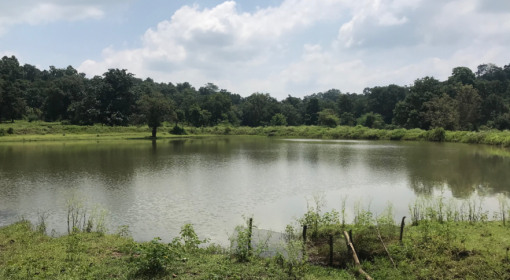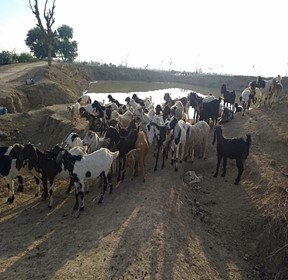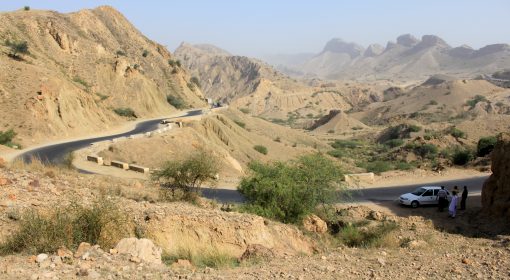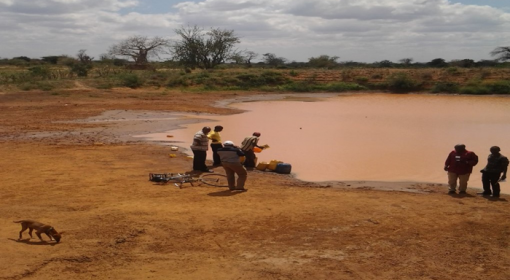From the mother of all ponds: road water harvesting in Masala, Ethiopia
By Francesco Sambalino and Cecilia Borgia
January 03, 2020
West Hararghe has been for centuries at the cross road of cultures and agro ecological zones. Its specific conditions made West Hararghe and especially Masala woreda a producer of top quality coffee and khat. Nevertheless the rugged terrain poses a challenge in regards of water access. The valleys are blessed by abundance of water in the form of perennial springs and rivers. On the other hands the communities at higher locations have had to rely on water resources outside their village or to ingeniously manage the only source of water available: rainwater.
Water from roads
The closest source of perennial water is four hours away from Kufanzik community. Consequently, over a hundred years ago, the elders decided to construct a water harvesting pond to retain the water that is abundant during the rainy season (see Figure 1). The pond location was determined by the presence of highly impermeable clay (called Faaroo in Afan Oromo) and by suitable topography. The pond is situated on a ridge and the water is sourced from the road that winds along the ridge crest through a series of gentle hilltops. In the beginning the pond was of a small size and was sufficient to provide water to the whole community and its livestock. Over the years, the pond has expanded in diameter and depth to accommodate the needs of the growing community. The pond rarely dries up.


The Water Harvesting Pond in Kufanzik
The system is characterized by five main components with distinct functions (see Figure 3):
1. A 1.6 km long conveyance ditch that runs parallel to the road and collects water from the adjoining slopes. The ditch is on the same level of the road except when a depression needs to be bridged. In this case the canal is elevated thanks to small embankments.
2. A shallow ford connects the canal to the main reservoir, which is situated on the opposite side of the road (see Figure 2a/2b). By obstructing the canal the water is diverted through the ford into the pond (Figure 2b). Not all the runoff is collected. The first rains are usually flushed away because they bring more dirt and silt (Figure 2a). Since the pond has not a proper spillway, the ford is managed as a gate to stop the flow into the reservoir.
(Left) The early rain runoff is not collected but used to clean the canal system. (Right) After the early rains, the canal is obstructed to divert the water through the ford to the reservoir
3. The reservoir has a round shape and a diameter of 30 m. It is used only for household uses and its access is well regulated.
4. A ring-shaped embankment around the reservoirs has been formed with excavated earth as well as with the silt that is removed during the maintenance work. The embankment is covered with grass that is kept short and tidy. The grass functions as a buffer strip that helps to clean the inflowing water of debris. Surrounding the outer perimeter of the embankment there is a thick fence made of bushes. A door (4b) with a lock is the only access point and is regulated by strict timing and rules. The key is held by the key master, which is elected by the community and leaves near the reservoir.
5. A secondary, smaller pond has been dug for livestock use.
Water access and use
Three communities for a total of around 200 households can access the pond daily. Each family has right to two jerry cans of water per day and the water is used to satisfy all household needs. Only in case of special events such as weddings and can the users obtain an extra amount of water. Only those who routinely contribute to the maintenance of the structure have automatic access rights.
The rules that regulate access have changed in time. Nowadays, water cannot be used for livestock and there are strict access times to the pond in order to control unregulated withdrawal. The guardian of the pond guarantees access for four hours every morning. Elders and people with health issues can get special permissions.
Management and Maintenance
The management of the pond is in the hand of the community through a management team comprising of 9 members from 5 core communities. The management team takes decisions regarding operation and maintenance, and decides upon penalties and exceptions.
Maintenance during the dry season implies digging up sediments from the reservoir, strengthening the embankment and filling the gaps in the vegetative fence. During the wet season management operations go together with operations. Each runoff pulse is managed singularly and its water is either collected or flushed out according to the quality of the water and the level reached in the reservoir. The first runoff water of the season is used to clean the canals and is not collected due to its poor quality.
The embankment grass is kept short throughout the year and the cut material is sold on the market. The earnings are used to cover maintenance costs.
To ensure higher water quality four precautions are deployed. First, the first rains runoff is not collected but used to flush debris and garbage out of the canals. Second, no animals can access the perimeter of the reservoirs and people are required to take off the shoes before fetching water. Third, the grass on the embankment not only stabilizes the structure, but also helps filtering the incoming runoff water. Fourth, a flocculent is added to the reservoir twice per season to reduce the amount of particles suspended in the water.

Learning from success
The structure is referred to as the “mother of all ponds” in this area, since it was the fruit of trials and local innovation, and stimulated the construction of similar ponds in other communities along the mountain ridge. Nowadays more than 15 ponds of the same kind are in use. The traditional management system and bylaws that regulate its use are an example of good local governance. The woreda – following the same technical principles – has built a big water harvesting pond.
However, while the good physical design has held on, the good management system has been eroding over the years. The lack of an effective management team, rules and maintenance has led to overuse and mismanagement. An unrestricted number of livestock and people are now able to access the water. It is increasingly difficult to monitor water withdrawal limits, and to keep pollution under check. The absence of well-defined duties and rights has created a situation where no one feels obliged to carefully maintain and operate this otherwise skilfully designed pond.

{jcomments on}






